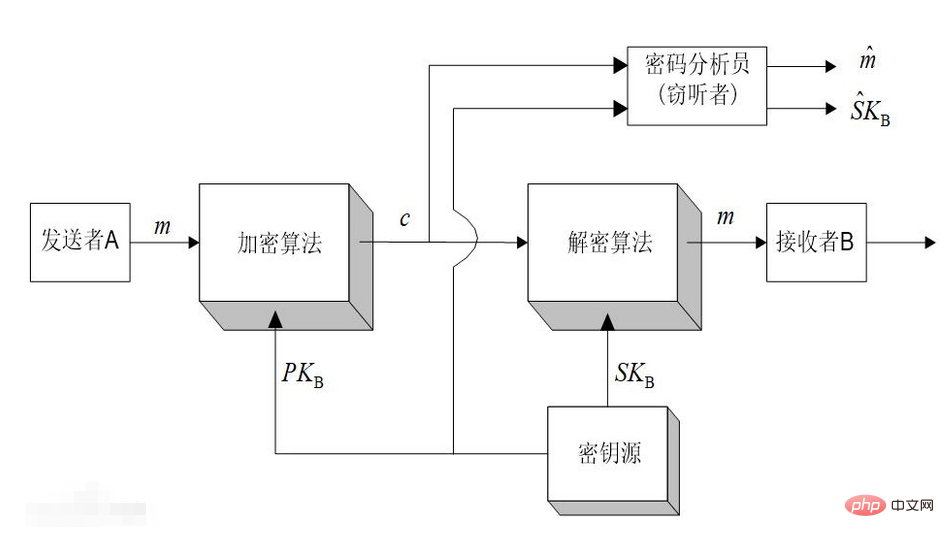
Cryptosystems with different encryption and decryption keys are called public key encryption systems; public key encryption is also called asymmetric encryption. Public key encryption is asymmetric and uses only one key. Compared with symmetric conventional encryption, it involves the use of two independent keys, one key is called the private key, which is kept secret, and the other key is called the public key and does not need to be kept secret.

The operating environment of this tutorial: Windows 10 system, DELL G3 computer.
A cryptographic system with different encryption and decryption keys is called a public key encryption system.
Public key cryptography uses different encryption keys and decryption keys. It is a kind of "it is computationally infeasible to derive the decryption key from the known encryption key." Cryptosystem.
The emergence of public key cryptography is mainly due to two reasons. One is due to the key distribution problem of conventional key cryptography, and the other is due to the need for digital signatures.
Public key encryption is also called asymmetric encryption. Public key encryption is asymmetric. Compared with symmetric conventional encryption that uses only one key, it involves the use of two independent keys.
A key is called a private key, which is kept secret. The other key is called the public key and does not need to be kept secret.

Expand knowledge
The traditional encryption method is to use the same key for encryption and decryption, and the sender and receiver respectively Save, used during encryption and decryption. The main problem with this method is that the generation, injection, storage, management, distribution, etc. of keys are complicated, especially as the number of users increases, the demand for keys increases exponentially. In network communication, the distribution of a large number of keys is a difficult problem to solve.
For example, if there are n users in the system, and password communication needs to be established between every two users, then each user in the system must master (n-1) keys, and the system requires The total number of keys is n*(n-1)/2. For the case of 10 users, each user must have 9 keys, and the total number of keys in the system is 45. For 100 users, each user must have 99 keys, and the total number of keys in the system is 4950. This only considers the case where only one session key is used for communication between users. The generation, management, and distribution of such a large number of keys is indeed a difficult problem to handle.
In 1976, two scholars from Stanford University, Diffie and Herman, proposed the concept of public key cryptography.
In the public key cryptography system, the encryption key (i.e., the public key) PK is public information, while the decryption key (i.e., the secret key) SK needs to be kept secret. Encryption algorithm E and decryption algorithm D are also public. Although the secret key SK is determined by the public key PK, SK cannot be calculated based on PK.
Different from traditional encryption methods, this technology uses two different keys to encrypt and decrypt information. It is also called an "asymmetric encryption method. Each user has an encryption algorithm that is disclosed to the outside world. E and the externally confidential decryption algorithm D, they must meet the conditions: (1) D is the inverse of E, that is, D[E(X)]=X; (2) Both E and D are easy to calculate. (3) Starting from E It is very difficult to solve D. From the above conditions, it can be seen that under the public key cryptography system, the encryption key is not equal to the decryption key. The encryption key can be made public, so that any user can use the public key to publicize the information transmitted to this user. The key is encrypted and sent, and the only private key saved by the user is confidential, and only it can restore and decrypt the ciphertext. Although the decryption key can theoretically be calculated from the encryption key, in practice this algorithm design It is impossible, or although it can be calculated, it will take a long time and become infeasible. Therefore, making the encryption key public will not endanger the security of the key. The characteristics of the mathematical one-way trapdoor function are It is easy to evaluate in one direction, but its reverse calculation is very difficult. For many functions of the form Y=f(x), for a given independent variable x value, it is easy to calculate the value of the function Y; and from the given Y value, in many cases it is very difficult to calculate the x value according to the functional relationship f(x). For example, it is easier to calculate the product n obtained by multiplying two large prime numbers p and q, but their product n is decomposed into two large prime numbers p and q are very difficult. If n is large enough, the current algorithm cannot be implemented in an effective time.
For more related knowledge, please visit the FAQ column!
The above is the detailed content of What are cryptosystems with different encryption and decryption keys called?. For more information, please follow other related articles on the PHP Chinese website!
 MySQL changes root password
MySQL changes root password
 How to set password in windows
How to set password in windows
 Complete collection of SQL query statements
Complete collection of SQL query statements
 What are the characteristics of LAN
What are the characteristics of LAN
 What is the role of kafka consumer group
What is the role of kafka consumer group
 Domestic digital currency platform
Domestic digital currency platform
 Dynamic link library initialization routine failed
Dynamic link library initialization routine failed
 The difference between mac air and pro
The difference between mac air and pro